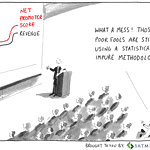Over the past couple of weeks, I have seen quite a lot of negative feedback about Net Promoter Score®. This issue seems to not be Net Promoters as such or how to calculate the score, but whether it is a valid measurement at all.
While I’ve responded to a couple of specific blog posts, I thought it would be useful to set out those comments in a central place.
Before I start, I do need to say that my view of customer management is pragmatic. In general, I believe it to be much better to do something that is 90% right than wait for the perfect solution. As one of my earliest mentors told me: in management if you get it right 70% of the time, you’ll be doing better than most.
It’s not just one number
Net Promoter Score seems to be a victim of its own success in the simplicity that is it’s hallmark. People seem to have taken the title to Fred Reichheld’s book “The Ultimate Question…” to heart as meaning there is only one question that holds all the answers.
In truth it isn’t just one question. The “would recommend” question and conversion to Net Promoter Score is important; important because the NPS® has been shown to correlate with business growth. This means that it is a useful proxy for customer loyalty, growth, etc. A proxy that is easy to measure capture and link to individual customers.
But that is not enough. Weighing a pig does not make it fatter . It does not relieve you of the need to understand how to drive changes in customer perception.
To drive business value, you must combine the NPS question with qualitative and quantitative questions that diagnose why the customer has scored you in that way and how you can improve. The most common way to do this in Transactional NPS surveys is to add a second qualitative question that asks “why” the customer gave such a score.
In much of the Relationship NPS work that we have done for our clients over the past 6 years we have included a range of customer loyalty driver attributes in the in same survey. Through analysis of the responses we can then understand what it important to the customer.
Using NPS at the output variable makes it easier for the organisation to collect and analyse this information because there is less (no) need to link customer survey feedback responses to specific customer behaviour. You could achieve even better outcomes than using NPS if you were able to link customer survey responses to a customer’s lifetime purchasing behaviour. Sadly, even using modern ERP and CRM solutions, in practice this is rarely easy and often impossible.
The point is that while NPS is just one question it does not mean that there is only one question that need be asked of customers.
Get the Business Leader's Guide to Net Promoter Score Download Here


